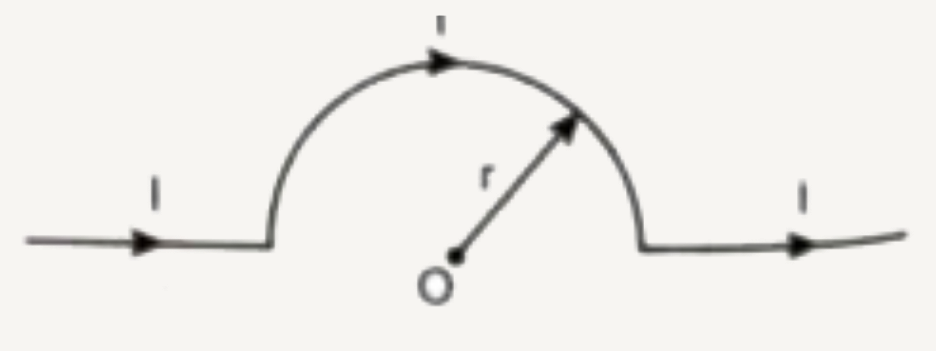A particle of charge q moves with velocity →v along positive y - direction in a magnetic field →B. Compute the Lorentz force experienced by the particle (a) when magnetic field is along positive y-direction (b) when magnetic field points in positive z -direction (c ) when magnetic field is in zy - plane and making an angle θ with velocity of the particle. Mark the direction of magnetic force in each case. Solution in Tamil
Velocity of the particle is →v=vˆj
(a) Magnetic field is along positive y-direction, this implies, →B=vˆj
From Lorentz force, −→Fm=q(vˆj×Bˆj) = 0
So, no force acts on the particle when it moves along the direction of magnetic field.
(b) Magnetic field points in positive z - direction, this implies,
→B=BˆK
From Lorentz force,
−→Fm=q(vˆj×Bˆk)=qvBˆi
Therefore, the magnitude,of the Lorentz force is qvB and direction is along positive x - direction .
(c ) Magnetic field is in zy - plane and making an angle θ with the velocity of the particle , which implies
→B B cosθaht(j)+ B sin θˆk
From Lorentz force,
−→Fm=q(vˆj)×(Bcosθˆj+Bsinθˆk)
= qvBsin θˆi


Topper's Solved these Questions
- BOOK - FULL MARKSCHAPTER - MAGNETISM AND MAGNETIC EFFECTS OF ELECTRIC CURRENT EXERCISE - TEXT EVALUATION SOLVED15videos
MAGNETISM AND MAGNETIC EFFECTS OF ELECTRIC CURRENT
- BOOK - FULL MARKSCHAPTER - MAGNETISM AND MAGNETIC EFFECTS OF ELECTRIC CURRENT EXERCISE - TEXT EVALUATION SOLVED -SHORT ANSWER QUESTIONS10videos
MAGNETISM AND MAGNETIC EFFECTS OF ELECTRIC CURRENT
- BOOK - FULL MARKSCHAPTER - ELECTROSTATICS EXERCISE - ADDITIONAL QUESTIONS SOLVED ( VII. NUMERICAL PROBLEMS )5videos
ELECTROSTATICS
- BOOK - FULL MARKSCHAPTER - OPTICSEXERCISE - ADDITIONAL QUESITON - II ADDITIONAL PROBLEMS:11videos
OPTICS
Similar Questions
The magnetic field at the center O of the following current loop is ............ .
 03:03View Solution
03:03View SolutionWhat is meant by magnetic induction ?
02:35View SolutionElectrons are caused to fall through a potential difference of 1500 volts. If they were initially at rest. Then calculate their final speed.
05:43View SolutionLight from a point source in air falls on a spherical glass surface (n = 1.5 and radius of curvature = 20 cm ). The distance of the light source from the glass surface is 100 cm. At what position the image is formed ?
02:21View SolutionAn electron moving with a uniform velocity along the positive x-direction enters a magnetic field directed along the positive y-direction. The force on the electron is directed along
04:45View SolutionWhat is the direction of the force acting on a charged particle q, moving with a velocity →v a uniform magnetic field →B ?
02:04View Solutionकिसी आवेशित कण को चुम्बकीय क्षेत्र में प्रवेश कराये जाने पर कण पर आरोपित बल शून्य होगा यदि कण की गति तथा चुम्बकीय क्षेत्र की दिशा के बीच कोण है :
02:21View SolutionPositively charged particles are projected into a magnetic field. If the direction of the magnetic field is along the direction of motion of the charged particles, the particles get
02:29View SolutionWhat is the direction of the force acting on a charged particle q, moving with a velocity vec(v) a uniform magnetic field vec(B) ?
01:42View SolutionA charged particle is moving in the direction of the magnetic field. Magnetic force on particle:
03:05View SolutionAn electron moving with a uniform velocity along the positive x-direction enters a magnetic field directed along the positive y-direction. The force on the electron is directed along
01:25View SolutionAn electron moving with a uniform velocity along the positive x-direction enters a magnetic field directed along the positive y-direction. The force on the electron is directed along
02:12View SolutionIf the magnetic field is parallel to the positive y axis and the charged particle is moving along the positive x axis, then what would be the direction of Lorentz force be for:- an electron
02:31View SolutionIf the magnetic field is parallel to the positive y axis and the charged particle is moving along the positive x axis, then what would be the direction of Lorentz force be for:- a proton.
02:39View Solutionधनात्मक आवेशित कणों को चुंबकीय क्षेत्र में प्रक्षेपित किया जाता है। यदि चुंबकीय क्षेत्र की दिशा आवेशित कणों की गति की दिशा के अनुदिश है, तो कण हो जाते हैं:
View Solution

